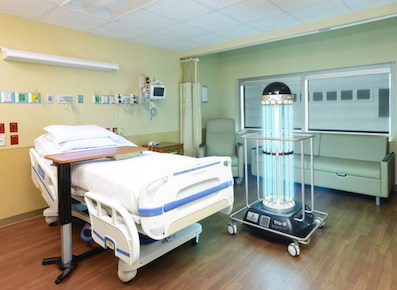 Cleanzine: your weekly cleaning and hygiene industry newsletter 3rd July 2025 Issue no. 1169
Cleanzine: your weekly cleaning and hygiene industry newsletter 3rd July 2025 Issue no. 1169
Your industry news - first
The original and best - for over 20 years!
We strongly recommend viewing Cleanzine full size in your web browser. Click our masthead above to visit our website version.
C. diff rates reduced with bundled approach as part of infection reduction program
 A new manuscript has been accepted by the Journal of the American College of Surgeons which examines C. diff in adult surgical patients.
A new manuscript has been accepted by the Journal of the American College of Surgeons which examines C. diff in adult surgical patients.
The paper, 'Multidisciplinary Approach and Clostridium difficile Infection in Adult Surgical Patients', discusses the multidisciplinary program that Duke University Medical Center implemented to reduce its C. diff rate.
Tru-D is used to disinfect patient rooms, operating rooms and other areas in healthcare facilities.
In 2017, Duke University Medical Center was identified as a 'High Outlier' for postoperative C. diff infections in the American College of Surgeons NSQIP semi-annual report with 0.4% cases per year with an increased risk in morbidity and mortality. To address the issue, the Department of Surgery initiated a CDI Task Force with representation from Surgery, Infectious Disease, Pharmacy & Performance Services to analyse available data, identify opportunities for improvement and implement strategies to reduce CDI.
Strategies to reduce CDI included antimicrobial stewardship optimisation, increased use of Tru-D SmartUVC for terminal cleaning of CDI patient rooms, increased hand hygiene and PPE signage as well as monitoring in high-risk CDI areas, improved diagnostic stewardship by an electronic best-practice advisory to reduce inappropriate CDI testing, education through surgical grand rounds and routine data feedback via NSQIP and NHSN CDI reports.
Using these strategies, observed rates of C. diff decreased from 1.27% in 2016 to 0.91% in 2017, a 28% decrease.
"Reducing hospital-acquired infections, especially C. diff, takes a multidisciplinary approach and a commitment to numerous infection prevention protocols," notes Alice Brewer, MPH, CIC, director of clinical affairs for Tru-D SmartUVC.
The manuscript states: "We reviewed the terminal cleaning policies for rooms occupied by patients with known CDI once they were discharged from the hospital. Additionally, the success at eliminating C. difficile through the established terminal cleans was verified through an auditing process.
"However, the audit demonstrated that there was variability and ineffective cleaning practices within the hospital system. These deficiencies were largely due to lack of Environmental Services staff and staff trained in Tru-D technology."
The conclusion provided a basis for requesting the hiring and training of additional environmental services staff and expanded training for terminal cleans was used for the Tru-D technology system, a system which uses an ultraviolet light cleaning system to denature the spores of C. difficile. This provided more effective terminal cleaning.
By training five additional Tru-D operators, the facility went from using Tru-D on 30% of C. diff rooms to 100% of C. diff rooms. "Appropriately trained Tru-D technicians increased in number following the initiative from two in 2017 to seven in 2019," states the manuscript. "This increase in technicians allowed for an increase in terminal cleans by Tru-D Ultraviolet therapy from 30% in March 2017 to 100% in September 2018."
Validated by multiple studies including the only randomised clinical trial on UVC disinfection, Tru-D has been proven to be a chemical-free and environmentally-friendly way of providing thorough room disinfection. UVC is a type of energy that is invisible to the human eye. Its wavelengths are between 200 and 300 nanometers, making them germicidal - meaning they are capable of inactivating microorganisms, such as bacteria, viruses and protozoa.
Alice Brewer says: "It has been proven that increased utilisation of Tru-D and UVC disinfection technology correlates to a reduction in hospital-acquired infections, including C. diff.
"By training additional staff in the operation of Tru-D, Duke was able to achieve 100% utilisation, which helped to contribute to the 28% reduction in C. diff infections."
A video on the power of one placement and one cycle is available at:
28th February 2019







